Marriage Material
How an Enduring Institution Is Changing Same-Sex Relationships
9780226836263
9780226836249
9780226836256
Marriage Material
How an Enduring Institution Is Changing Same-Sex Relationships
A cutting-edge study of marriage’s transformative effects on same-sex relationships.
It is no secret that marriage rates in the United States are at an all-time low. Despite this significant decline, marriage remains a profound institutional force that is deeply internalized in our society. How does the continuing strength of marriage impact the relationships of same-sex couples following the legalization of same-sex marriage?
Drawing on over one hundred interviews with LGBQ people, Marriage Material uncovers how the institution of marriage endures amid historic changes to its meaning and practice. Sociologist Abigail Ocobock looks to same-sex couples across a wide age range to examine how marriage equality has affected their approach to relationships. Ocobock offers much-needed insight into how marriage shapes individual behavior through a system of legal, social, and cultural mechanisms that work both independently and in tandem for a wide range of married couples. She probes both the power of marriage to transform same-sex relationships and of queer people to transform heteronormative assumptions about marriage, highlighting the complex interplay between institutional constraint and individual agency.
Marriage Material presents a bold challenge to dominant scholarly and popular ideas about the decline of marriage, making clear that gaining access to legal marriage has transformed same-sex relationships, for both better and worse.
It is no secret that marriage rates in the United States are at an all-time low. Despite this significant decline, marriage remains a profound institutional force that is deeply internalized in our society. How does the continuing strength of marriage impact the relationships of same-sex couples following the legalization of same-sex marriage?
Drawing on over one hundred interviews with LGBQ people, Marriage Material uncovers how the institution of marriage endures amid historic changes to its meaning and practice. Sociologist Abigail Ocobock looks to same-sex couples across a wide age range to examine how marriage equality has affected their approach to relationships. Ocobock offers much-needed insight into how marriage shapes individual behavior through a system of legal, social, and cultural mechanisms that work both independently and in tandem for a wide range of married couples. She probes both the power of marriage to transform same-sex relationships and of queer people to transform heteronormative assumptions about marriage, highlighting the complex interplay between institutional constraint and individual agency.
Marriage Material presents a bold challenge to dominant scholarly and popular ideas about the decline of marriage, making clear that gaining access to legal marriage has transformed same-sex relationships, for both better and worse.
288 pages | 6 x 9
Sociology: Demography and Human Ecology, Individual, State and Society, Sociology--Marriage and Family
Table of Contents
Introduction: Rethinking Marriage
Part I. Gaining Marriage
1. Marriage Embracers: The Power of Marriage, Old and New
2. Marriage Rejecters: Navigating the Pulls of Marriage
3. Marriage Assumers: It’s Just What You Do
Part II. Doing Marriage
4. Getting Engaged: Proposal Pressures
5. Feeling and Behaving Differently: Fights and Finances
6. Doing Marriage Differently: Marital Nonmonogamy
Conclusion
Acknowledgments
Methods Appendix
Notes
References
Index
Part I. Gaining Marriage
1. Marriage Embracers: The Power of Marriage, Old and New
2. Marriage Rejecters: Navigating the Pulls of Marriage
3. Marriage Assumers: It’s Just What You Do
Part II. Doing Marriage
4. Getting Engaged: Proposal Pressures
5. Feeling and Behaving Differently: Fights and Finances
6. Doing Marriage Differently: Marital Nonmonogamy
Conclusion
Acknowledgments
Methods Appendix
Notes
References
Index
